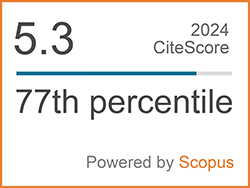Detecting Changes in the Mean of an Integration and Fractionally Integrated MA Process on Double Modified EWMA Control Chart
Abstract
Keywords
[1] W. A. Shewhart, “Quality control charts,” The Bell System Technical Journal, vol. 5, no. 4, pp. 593–603, 1926, doi: 10.1002/j.1538-7305.1926. tb00125.x.
[2] D. C. Montgomery, Introduction to Statistical Quality Control, 8th ed., NJ: John Wiley & Sons, 2020.
[3] W. H. Woodall, “Controversies and contradictions in statistical process control,” Journal of Quality Technology, vol. 32, no. 4, pp. 341–350, 2000.
[4] C. M. Borror, The Certified Quality Engineer Handbook, 3rd ed., WI: ASQ Quality Press, 2008.
[5] E. S. Page, “Continuous inspection schemes,” Biometrika, vol. 41, no. 1/2, pp. 100–115, 1954, doi: 10.2307/2333009.
[6] S. W. Roberts, “Control chart tests based on geometric moving averages,” Technometrics, vol. 42, no. 1, pp. 97–101, 2000, doi: 10.1080/ 00401706.2000.10485986.
[7] J. M. Lucas and M. S. Saccucci, “Exponentially weighted moving average control schemes: Properties and enhancements,” Technometrics, vol. 32, no. 1, pp. 1–12, Feb. 1990, doi: 10.1080/00401706.1990.10484583.
[8] N. Khan, M. Aslam, and C. H. Jun, “Design of a control chart using a modified EWMA statistic,” Quality and Reliability Engineering International, vol. 33, no. 5, pp. 1095–1104, 2017, doi: 10.1002/qre.2102.
[9] V. Alevizakos, K. Chatterjee, and C. Koukouvinos, “Modified EWMA and DEWMA control charts for process monitoring,” Communications in Statistics-Theory and Methods, vol. 51, no. 21, pp. 7390–7412, 2022, doi: 10.1080/03610926.2021.1872642.
[10] G. Capizzi and G. Masarotto, “A general class of control charts based on two-stage monitoring schemes,” Technometrics, vol. 45, no. 4, pp. 268–279, 2003.
[11] G. E. P. Box and G. M. Jenkins, Time Series Analysis: Forecasting and Control, NY: Holden-Day, 1976.
[12] S. M. Ross, Introduction to Probability Models, 11th ed., MA: Academic Press, 2014.
[13] D. M. Hawkins and K. D. Zamba “Numerical integration for control chart ARL estimation,” Journal of Quality Technology, vol. 37, no. 1, pp. 56–67, 2005.
[14] K. Petcharat, S. Sukparungsee, and Y. Areepong, “Exact solution of the average run length for the cumulative sum chart for a moving average process of order q,” ScienceAsia, vol. 41, no. 2, pp. 141–147, 2015, doi: 10.2306/scienceasia 1513-1874.2015.41.141.
[15] K. Petcharat, Y. Areepong, and S. Sukparungsee, “Exact solution of average run length of EWMA chart for MA(q) processes,” Far East Journal of Mathematical Sciences (FJMS), vol. 2, no. 2, pp. 1–10, 2013.
[16] Y. Supharakonsakun, “Statistical design for monitoring process mean of a modified EWMA control chart based on autocorrelated data,” Walailak Journal of Science and Technology, vol. 18, no. 12, 2021, Art. no. 19813, doi: 10.48048/wjst.2021.19813.
[17] Y. Supharakonsakun and Y. Areepong, “ARL evaluation of a DEWMA control chart for autocorrelated data: A case study on prices of major industrial commodities,” Emerging Science Journal, vol. 7, no. 5, pp. 1771–1786, Oct. 2023, doi: 10.28991/ESJ-2023-07-05-020.
[18] J. Neammai, S. Sukparungsee, and Y. Areepong, “Explicit analytical form for the average run length of double-modified exponentially weighted moving average control charts through the MA(q) process and applications,” Symmetry, vol. 17, no. 2, p. 238, 2025, doi: 10.3390/sym 17020238.
[19] P. Phanthuna and Y. Areepong, “Detection sensitivity of a modified EWMA control chart with a time series model with fractionality and integration,” Emerging Science Journal, vol. 6, no. 5, pp. 1005–1018, 2022, doi: 10.28991/ESJ-2022-06-05-015.
[20] L. L. Ho, F. H. Fernandes, and M. Bourguignon, “Control charts to monitor rates and proportions,” Quality and Reliability Engineering International, vol. 35, no. 1, pp. 74–83, 2019.
[21] P. Phanthuna, Y. Areepong, and S. Sukparungsee, “Run length distribution for a modified EWMA scheme fitted with a stationary AR(p) model,” Communications in Statistics - Simulation and Computation, pp. 1–20, 2021, doi: 10.1080/03610918.2021.1958847.
[22] G. Burova and V. M. Ryabov, “On the solution of fredholm integral equations of the first kind,” WSEAS Transactions on Mathematics, vol. 19, pp. 699–708, 2020, doi: 10.37394/23206.2020. 19.76
[23] D. Han and F. Tsung, “A reference-free cuscore chart for dynamic mean change detection and a unified framework for charting performance comparison,” American Statistical Association, vol. 101, pp. 368–386, 2006, doi: 10.1198/ 016214505000000556
[24] V. Alevizakos, K. Chatterjee, and C. Koukouvinos, “The triple exponentially weighted moving average control chart for monitoring Poisson process,” Quality and Reliability Engineering International, vol. 38, pp. 532–549, 2023, doi: 10.1002/qre.2999.DOI: 10.14416/j.asep.2025.07.011
Refbacks
- There are currently no refbacks.
 Applied Science and Engineering Progress
Applied Science and Engineering Progress







